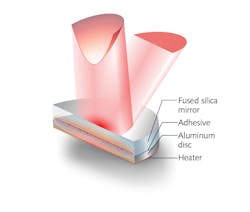Thermal bimorph mirror could improve sensitivity of gravitational wave detectors

A group of physicists from institutions around the world has developed a new type of adaptive-optical (AO) deformable mirror based on thermal actuation that could increase the sensitivity of ground-based gravitational wave detectors such as the Advanced Laser Interferometer Gravitational-Wave Observatory (LIGO). Research team leader Huy Tuong Cao from the University of Adelaide node of the Australian Center of Excellence for Gravitational Waves Discovery (OzGrav) and his team have, for the first time, made a deformable mirror based on a bimorph effect similar to the bimetallic effect, in which two attached dissimilar metals attached together and with different coefficients of thermal expansion are heated, therefore achieving mechanical displacement (warpage). In the case of the AO mirror, it is metal and glass, rather than two dissimilar metals, that expand differently when heated. As Cao notes, the simplicity of the design means that it could also be used more widely, turning commercially available optics into a deformable mirror without any complicated or expensive equipment.
Most deformable mirrors use thin mirrors to allow large amounts of actuation, but these thin mirrors can produce undesirable scattering because they are hard to polish. The researchers bonded a 3-mm-thick aluminum disk to a 6-mm-thick fused-silica mirror with adhesive; the assembly also included a heater as the outer layer opposite to the mirror. The researchers developed and built a highly sensitive Hartmann wavefront sensor to characterize the mirror’s deformations. Heating the mirror assembly caused the mirror to add optical power, which in use in LIGO would achieve a mode-mismatch correction. The mirror recovered its original shape after the heat was removed, as long as the heat applied was not enough to cause the epoxy adhesive to exceed its shear stress limit. The new design not only creates a large amount of precise actuation, but is also compact and requires minimum modifications to existing systems. Both the fused-silica mirrors and aluminum plates used to create the deformable mirror are commercially available. The researchers are currently working to overcome the limitation caused by the adhesive and will perform more tests to verify compatibility before incorporating the mirrors into Advanced LIGO. Reference: H. T. Cao et al., Appl. Opt., 59, 9, 2784–2790 (2020); https://doi.org/10.1364/AO.376764.
About the Author
John Wallace
Senior Technical Editor (1998-2022)
John Wallace was with Laser Focus World for nearly 25 years, retiring in late June 2022. He obtained a bachelor's degree in mechanical engineering and physics at Rutgers University and a master's in optical engineering at the University of Rochester. Before becoming an editor, John worked as an engineer at RCA, Exxon, Eastman Kodak, and GCA Corporation.
